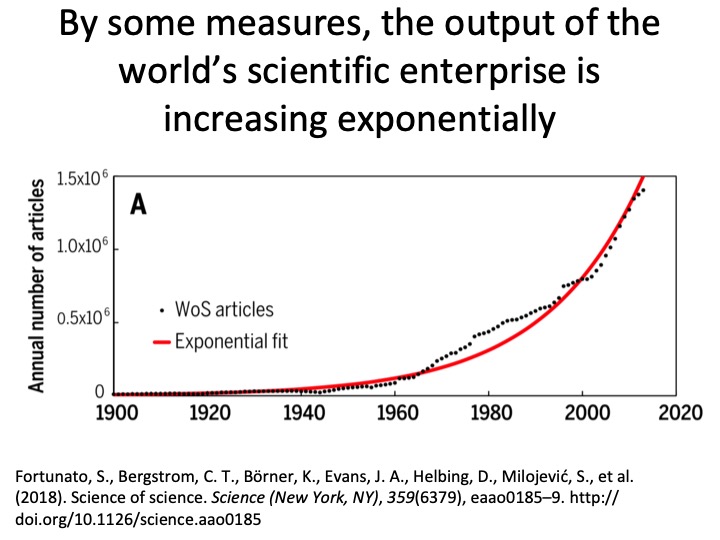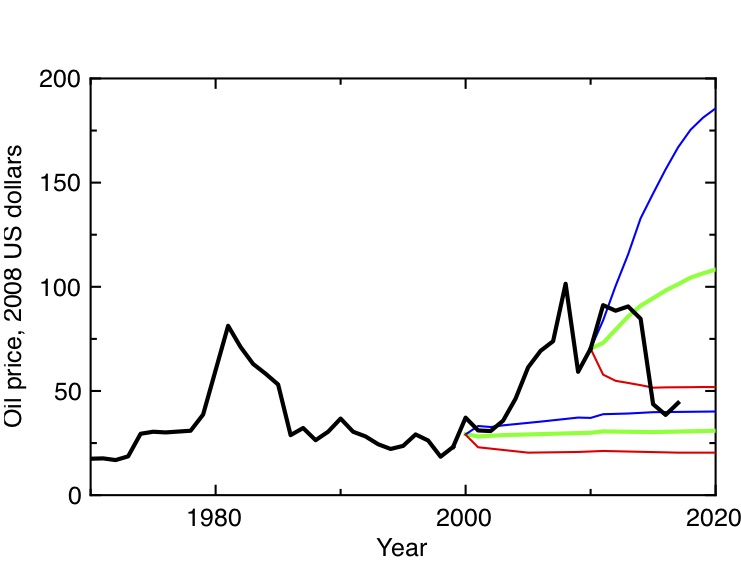The rock climber Alex Honnold’s free, solo ascent of El Capitan is inspirational in many ways. For economist John Cochrane, watching the film of the ascent has prompted a blogpost: “What the success of rock climbing tells us about economic growth”. He concludes that “Free Solo is a great example of the expansion of ability, driven purely by advances in knowledge, untethered from machines.” As an amateur in both rock climbing and innovation theory, I can’t resist some comments of my own. I think it’s all a bit more complicated than Cochrane thinks. In particular his argument that Honnold’s success tells us that knowledge – and the widespread communication of knowledge – is more important than new technology in driving economic growth doesn’t really stand up.
The film “Free Solo” shows Honnold’s 2017 ascent of the 3000 ft cliff El Capitan, in the Yosemite Valley, California. The climb was done free (i.e. without the use of artificial aids like pegs to make progress), and solo – without ropes or any other aids to safety. How come, Cochrane asks, rock climbers have got so much better at climbing since El Cap’s first ascent in 1958, which took 47 days, done with “siege tactics” and every artificial aid available at the time? “There is essentially no technology involved. OK, Honnold wears modern climbing boots, which have very sticky rubber. But that’s about it. And reasonably sticky rubber has been around for a hundred years or so too.”
Hold on a moment here – no technology? I don’t think the history of climbing really bears this out. Even the exception that Cochrane allows, sticky rubber boots, is more complicated than he thinks.
When the modern sport of climbing began, more than a hundred years ago, people wore boots – nailed boots – on their feet (as they would do for pretty much any outdoor activity). There is a lost technology of the best types of nails and nailing patterns to use, but it’s true that, as harder climbs were done in the 1920s and 30s, the leading climbers of the day tended to use tennis shoes or plimsolls for the hardest climbs. But these were everyday footwear, in no way designed for climbing.
I believe the first shoes designed specifically for rock climbing, of the kind that would be recognised as the ancestors of today’s shoes, came from France. These were designed by the alpinist Pierre Allain for use on the sandstone boulders of the Fontainbleau forest, a favoured training ground for the climbers of Paris. By the time I started climbing, in the 1970’s, the descendants of these shoes – the EB Super Gratton- had an almost complete worldwide monopoly on climbing shoes. They were characterised by a tight fit, a treadless rubber sole and a wide rand, allowing precise footwork and good friction on dry rock.
In 1982 the makers of EBs made a “New Coke” like marketing blunder, introducing a new model with a moulded sole – probably cheaper to manufacture, but thicker and less precise than the original. This might not have mattered given their existing market position, but a then unheard of Spanish shoe company – Boreal – had recently introduced a model of their own, with a sole made of a new kind of high friction rubber.
Rubber is a strange material, and the microscopic origins of friction in rubber are different to those in more conventional materials like metals. When a climber steps on a tiny foothold, the sole starts to slide against the rock, very slowly, usually imperceptibly. As the rubber slides past the asperities, the internal motions within the bulk of the rubber, of molecule against molecule, dissipate energy – and the greater the rate of energy dissipation, the higher the friction. This energy dissipation, though, is a very strongly peaked function of temperature – and as a consequence, a given rubber compound will have a temperature at which the friction is at a maximum.
Boreal, by accident or design, had found a rubber compound where the friction peaked much closer to room temperature than in EBs. Boreal’s new climbing boot – the “Firé” – swept the marketplace. The increased friction and the advantage this gave was obvious both to the leading climbers of the day, and the much more average performers. I was in the latter category, and succumbed to the trend. The improvement in performance the new shoes made possible was immediately tangible, the only downside being that Firés were cripplingly uncomfortable. Soon US and Italian competitors started selling boots with comparably high friction rubber that were actually foot-shaped.
Modern rock boots do make a difference, but this isn’t really the crucial technology that has enabled hard rock climbing. What’s made the biggest difference – both to the wider popularity of the sport and the achievements of its leading proponents – has been the development of technologies that allow one to fall off without dying.
Hold on, you might say here – wasn’t Alex Honnold climbing solo, without ropes, in a situation in which if he fell he would most certainly die? Yes, indeed, but Honnold didn’t get to be a good climber by doing a lot of soloing, he got to be a good soloist by doing a lot of climbing. Most of that climbing – especially the climbing where he was pushing himself – was done roped. To get himself ready for his El Cap solo, he spent hundreds of hours on the route, roped, working out and memorising all the moves.
When climbing started, every climb was effectively a solo, at least for the leader. Before the 2nd World War, climbing ropes were made of natural fibres – hemp or manila. They were strong – strong enough to hold a slip of a second on the rope. But they were brittle, and for the leader, any fall that would put a shock load on the rope was likely to break it. “The leader must not fall” was the stern instruction of books of the time. The knowledge that a fall would lead to death or serious injury was ever-present for a pre-war climber pioneering a new hard route, and it’s not difficult to imagine that this was a brake on progress.
As in other areas of technology, the war changed things. The new artificial fibre nylon was put into mass production for parachute cord for aircrew and airborne troops; its strength, resilience and elasticity made the postwar surpluses of the fibre ideal for making climbing ropes. Together with the invention of metal snap-links they made it possible to imagine a leader surviving a fall – the rope could be clipped to an anchor in the rock to make a “running belay”, limiting the length of the fall. In the USA and the European Alps, the anchors would usually be metal pegs hammered into cracks, while on the smaller crags of the UK a tradition developed of using jammed machine nuts threaded on loops of nylon..
By the 1960’s and 70’s, the likelihood was that a leader would survive a fall, but you wouldn’t want to do it too often. The job of arresting the fall went to the second, who would pass the rope round their back and use the force of their grip and the friction of the rope around their body to hold the fall. You had to be attentive, quick and decisive to do this without getting a bad friction burn, or at worst letting the rope go entirely. The crudest mechanical friction devices were devised in the early 70’s, and have now been developed to the point that a second no longer needs strength or skill to hold the rope of a falling climber. Meanwhile the leader would be tied on to the rope with a simple knot round the waist, making a fall painful – and a prolonged period of dangling, after a fall from overhanging rock, potentially fatal through asphyxiation. Simple but effective harnesses were developed in the 60’s and 70’s, which spread the force of arresting a fall onto the buttocks and thighs, and made the sudden stop at the end of a leader fall bearable, if not entirely comfortable.
In California, it was the particular character of the rock and the climbs, especially in Yosemite, that drove developments in the technology for anchoring the rope to the rock. Yvon Chouinard realised that the mild steel pegs used in the European Alps weren’t suitable for the hard granite of Yosemite, and he developed optimally shaped pegs from hard chrome-molybdenum alloy steel – the bongs, blades and leepers that I just about remember from my youth. But like other technological developments, this one had its downsides – the repeated placement and removal of these pegs from the cracks led to scarring and damage, which in the climate of heightened environmental awareness in the 60’s and 70’s led to some soul-searching by US climbers. A “clean-climbing” movement developed, with Chouinard himself one of its leaders. To replace steel pegs as anchors, the British tradition of jammed machine nuts as anchors was developed. Purpose designed chocks and wedges were marketed, like Chouinard’s cunningly designed “hexcentrics”, which would cam under load to hold even in parallel sided cracks.
It was another Californian devotee of Yosemite that made the real breakthrough in clean climbing protection, though. Ray Jardine, an aerospace engineer, devised an ingenious spring-loaded camming device that was easily placed and would hold a fall even if placed in a parallel sided or slightly flared crack. These were patented and commercialised as “Friends”. Many developments of this idea have since been put on the market, and these form the basis of the “rack” of anchoring equipment that climbers carry today.
It’s this combination of strong and resilient nylon ropes, able to absorb the energy of a long fall, automatic braking gadgets to hold the rope when a fall happens, reliable devices for anchoring the rope to the rock, and harnesses that spread the load of a fall across the climbers body, that have got us to where we are today, where climbers can practise harder and harder routes, (mostly) safe in the knowledge that a fall won’t be fatal, or even that uncomfortable.
This is not to say that knowledge isn’t important, of course. All this equipment needs skill to use – and knowledge has helped in the sheer physical aspects of getting up steep rock. As well as the new technology, one of the causes of the big advances in rock climbing standards in the 1980’s was undoubtedly a change in attitude amongst leading climbers. Training was taken much more seriously than it had been before: training techniques were imported from athletics and gymnastics, artificial climbing walls were developed, and the discipline of trying out very hard moves close to the ground on boulders – pioneered by the American mathematician and gymnast John Gill – became popular.
I think one kind of knowledge is particularly important in climbing – and maybe in other areas of human endeavour, too. That’s simply the knowledge that something has already been done – the existence proof that a feat is possible. Guidebooks record that a climb has been done and where it goes, though not usually how to do it. To know in advance the physical details of how a climb is done – what climbers call “beta” – is considered to lessen the achievement of a subsequent ascent. But simply to know that the climb is possible (and have some idea of how hard it is going to be) is an important piece of information in itself.
How is knowledge transmitted? We have books – instructional books of technique, and guidebooks to particular climbing areas. And now we have the internet, so one can read and post questions on climbers internet forums. I’m not sure how much this has added to more traditional ways of conveying information – discussions on the most popular UK climbing forum seem to mostly consist of endless arguments about Brexit. But I do think there is one change that modern times have brought that makes a huge difference to knowledge transmission, and that is the advent of cheap air travel.
My first overseas climbing trips (in 1981 and 1982) were to the French Alps. These were hugely important to my development as a climber, and undoubtedly some part of that came from interactions with climbers from other countries with different traditions and different techniques. Big climbing centres tended to have well known places where climbers from different countries stayed and mixed (the squalid informal campsite known as Snell’s Field in the case of Chamonix, the legendary Camp 4 for Yosemite). I climbed with a couple of outstanding Australian climbers from the campsite while I was there, we picked up tips on big wall climbing from a Yosemite habitué, and I came home with half a dozen beautiful titanium ice screws, light, thin walled, and sharp. Such things were unobtainable in the West at the time; I’d bartered them from some East European climbers, but they had undoubtedly been knocked off after hours in some Soviet aircraft factory.
But getting to Chamonix had taken me nearly 24 hours on a bus. Nowadays climbers can take several holidays a year with easy and cheap air travel, to the sunshine in Spain or Greece or Thailand, the big mountains of the Himalayas or South America, desert climbing in Morocco, Jordan, or Oman, Nevada, Utah, or Arizona, to the subarctic conditions of Patagonia or Baffin Island, or to the more traditional centres like the Dolomites or Yosemite. This does lead to a rapid spread of attitudes and techniques. It’s a paradox, of course, that climbers, who love the wilderness and the world’s beautiful places, and are more environmentally conscious than most, make, through their flying, such an above average contribution to climate change. Can this go on?
So if John Cochrane has learnt the wrong lesson from rock climbing, what better lessons should we take away from all this?
Some economists love simple stories, especially when they support their ideological priors, but a bit of knowledge of history often reveals that the truth is somewhat more complicated. More importantly, perhaps, we should remember that technological innovation isn’t just about iPhones and artificial intelligence. All around us – in our homes, in everyday life, in our hobbies and pastimes – we can see, if we care to look, the products of all kinds of technological innovation in products and the materials that make them, that collectively lead to overall economic growth. Technological innovation doesn’t have to be about giant leaps and moonshots – even mundane things like shoe soles and ropes tell a story of a whole series of incremental changes that together add up to progress.
And to return to Alex Honnold, perhaps the most important lesson a free-market loving economist should draw is that sometimes people will do extraordinary things without the motivation of money.


